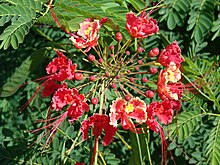Caesalpinia
| Caesalpinia | |
|---|---|

| |
| Caesalpinia pulcherrima | |
| Scientific classification | |
| Kingdom: | Plantae |
| Clade: | Tracheophytes |
| Clade: | Angiosperms |
| Clade: | Eudicots |
| Clade: | Rosids |
| Order: | Fabales |
| Family: | Fabaceae |
| Subfamily: | Caesalpinioideae |
| Tribe: | Caesalpinieae |
| Genus: | Caesalpinia Plum. ex L. (1853) |
| Type species | |
| Caesalpinia brasiliensis L.[2]
| |
| Species[1] | |
|
10; see text | |
| Synonyms[1] | |
| |
Caesalpinia is a genus of flowering plants in the family Fabaceae. It includes 10 species which range from southeastern Mexico through Central America to Colombia, Ecuador, and Peru, and to Cuba, Hispaniola, and the Bahamas.[1]
Historically, membership within the genus has been highly variable, with different publications including anywhere from 70 to 165 species, depending largely on the inclusion or exclusion of species alternately listed under genera such as Hoffmannseggia. It contains tropical or subtropical woody plants. The generic name honours the botanist, physician, and philosopher Andrea Cesalpino (1519–1603).[3]
The name Caesalpiniaceae at family level, or Caesalpinioideae at the level of subfamily, is based on this generic name.
Species
10 species are currently accepted:[1]
- Caesalpinia anacantha Urb.
- Caesalpinia bahamensis Lam.
- Caesalpinia barahonensis Urb.
- Caesalpinia brasiliensis L.
- Caesalpinia cassioides Willd.
- Caesalpinia domingensis Urb.
- Caesalpinia monensis Britton — black nicker
- Caesalpinia nipensis Urb.
- Caesalpinia pulcherrima (L.) Sw. — Pride of Barbados, yellow peacock
- Caesalpinia secundiflora Urb.
Uses
Some species are grown for their ornamental flowers.
References
- ^ a b c d Caesalpinia Plum. ex L. Plants of the World Online. Retrieved 13 August 2023.
- ^ "Caesalpinia L." TROPICOS. Missouri Botanical Garden. Retrieved 2009-10-19.
- ^ Gledhill, David (2008). The Names of Plants (4th ed.). Cambridge University Press. p. 83. ISBN 978-0-521-86645-3.
External links
 Media related to Caesalpinia at Wikimedia Commons
Media related to Caesalpinia at Wikimedia Commons Data related to Caesalpinia at Wikispecies
Data related to Caesalpinia at Wikispecies- USDA PLANTS Profile
